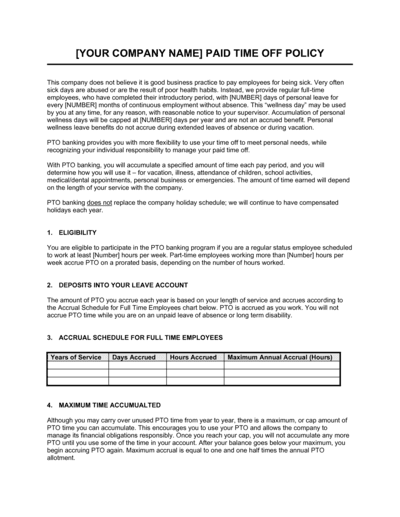
Paid-Time-Off Policy Template
Understanding a Paid Time Off Policy
In the modern workplace, fostering employee well-being and satisfaction is essential for retaining talent and maintaining high productivity. A Paid Time Off (PTO) Policy is a crucial element in this strategy, offering a consolidated leave system that encompasses vacation, sick, and personal leave into one flexible policy.
This policy is an essential tool, articulating the accrual rates, usage guidelines, and procedures for requesting time off. It not only provides employees with the necessary time to rest and recuperate but also simplifies administrative processes, ensuring a balance between the needs of the employees and the operational requirements of the organization. This policy goes beyond traditional separate leave systems; it is about supporting a holistic approach that values employee health, family needs, and personal time, thereby enhancing overall job satisfaction and loyalty.
What is a Paid Time Off Policy Template?
A Paid Time Off Policy template serves as a structured guide that outlines the key components necessary for managing a comprehensive PTO program. This includes details on the accrual of PTO days, the maximum carry-over limits, conditions under which PTO can be used, and the procedures for requesting and approving leave. Utilizing a template ensures a uniform approach to PTO administration across the organization, allowing customization to align with specific workplace cultures and regulatory requirements while promoting a clear, mutual understanding of the policy among all employees.
Key Elements of a Paid Time Off Policy
A robust Paid Time Off Policy should thoroughly address:
- Eligibility - Defines which employees are eligible for PTO, typically based on employment type or tenure.
- Accrual and Usage - Details how PTO is accrued, such as per pay period or year, and any rules regarding the increment of accrual based on seniority or other factors.
- Carry-Over and Expiration - Specifies how much PTO can be carried over into the next year and whether unused PTO expires or can be paid out.
- Request and Approval Process - Outlines the procedures for submitting PTO requests and how they are approved, including notice periods and priority considerations.
- Usage Restrictions - Describes any restrictions on PTO use, such as blackout dates during busy periods or limits on consecutive days off.
- Interaction with Other Leave Policies - Explains how PTO interacts with other specific leave types, such as maternity or disability leave, if applicable.
- PTO Payout upon Termination - Defines conditions under which PTO is paid out upon termination or resignation of an employee.
Supporting Documents for Structuring a Paid Time Off Policy
To enhance the effectiveness and comprehensiveness of a Paid Time Off Policy, integrating related documents is advisable:
- Vacation Request Form - Standardizes the process for requesting time off, ensuring consistency and ease of management.
- Employee Handbook - Incorporates the PTO policy into the broader context of company policies and employee benefits.
- Attendance Policy - Outlines expectations and procedures for attendance, linking it with PTO usage to manage and monitor leave and presence effectively.
- Compliance Checklist - This checklist helps ensure that the policy complies with local and federal labour laws, particularly regarding mandatory leave provisions.
Why Employ a Detailed Template for a Paid Time Off Policy?
Utilizing a detailed template for drafting your Paid Time Off Policy offers significant benefits:
- Clarity and Consistency - Ensures that all employees receive the same information and understand their rights and responsibilities regarding PTO.
- Adaptability - Allows for adjustments to meet the specific needs of the organization and its workforce, accommodating various work environments and cultural considerations.
- Streamlined Administration - Enhances the efficiency of handling leave requests and managing employee schedules, reducing administrative burden.
- Employee Satisfaction - Promotes a positive work environment by clearly supporting work-life balance, which can help attract and retain top talent.
Adopting a comprehensive Paid Time Off Policy is essential for modern organizations aiming to support their workforce effectively. It provides a clear, enforceable framework that outlines how employees can manage their time off, ensuring that both the operational needs of the organization and the personal needs of the employees are met harmoniously.
Updated in April 2024